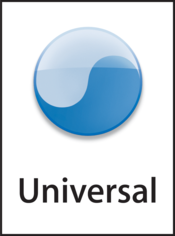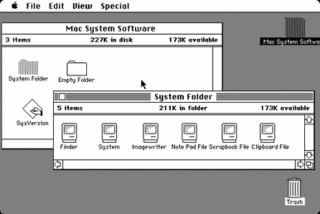External links
| Kernels |
| ||||||||||||||||||||||||
|---|---|---|---|---|---|---|---|---|---|---|---|---|---|---|---|---|---|---|---|---|---|---|---|---|---|
| Operating systems |
| ||||||||||||||||||||||||
| Frameworks, kits | |||||||||||||||||||||||||
| Developers | |||||||||||||||||||||||||
| |||||||||||||||||||||||||
| General | |||||
|---|---|---|---|---|---|
| Variants | |||||
| Kernel |
| ||||
| Process management |
| ||||
| Memory management, resource protection | |||||
| Storage access, file systems | |||||
| Supporting concepts | |||||
| Developer | Tenon Intersystems |
|---|---|
| OS family | Unix-like BSD |
| Working state | Discontinued |
| Source model | Closed source |
| Latest release | 4.1.4 |
| Platforms | Macintosh: Motorola 68000, then PowerPC |
| Kernel type | Microkernel |
| License | Commercial, proprietary |
| Official website | www |
MachTen is a Unix-like operating system from Tenon Intersystems. It is based on 4.4BSD and the Mach kernel, and features the X Window System and GNU programming tools. It runs only as a classic Mac OS application program (in a virtual machine) on Macintosh computers.
MachTen development started in 1989, culminating in the first release in 1991. The Professional MachTen branch, intended for Motorola 68000-based Macintoshes, ended with release 2.3. The Power MachTen branch, which is Power Macintosh compatible, lacks some of the features of Professional MachTen (including true virtual and protected memory models), but takes full advantage of the PowerPC processor and is compatible with Mac OS 9 through its final version, 4.1.4. MachTen is no longer developed, and is functionally superseded by macOS.
Darwin is an open-source Unix operating system first released by Apple Inc. in 2000. It is composed of code derived from NeXTSTEP, BSD, Mach, and other free software projects' code, as well as code developed by Apple.
OpenStep is a defunct object-oriented application programming interface (API) specification for a legacy object-oriented operating system, with the basic goal of offering a NeXTSTEP-like environment on non-NeXTSTEP operating systems. OpenStep was principally developed by NeXT with Sun Microsystems, to allow advanced application development on Sun's operating systems, specifically Solaris. NeXT produced a version of OpenStep for its own Mach-based Unix, stylized as OPENSTEP, as well as a version for Windows NT. The software libraries that shipped with OPENSTEP are a superset of the original OpenStep specification, including many features from the original NeXTSTEP.
The history of macOS, Apple's current Mac operating system formerly named Mac OS X until 2011 and then OS X until 2016, began with the company's project to replace its "classic" Mac OS. That system, up to and including its final release Mac OS 9, was a direct descendant of the operating system Apple had used in its Macintosh computers since their introduction in 1984. However, the current macOS is a Unix operating system built on technology that had been developed at NeXT from the 1980s until Apple purchased the company in early 1997.

A/UX is Apple Computer's Unix-based operating system for Macintosh computers, integrated with System 7's graphical interface and application compatibility. Launched in 1988 and discontinued in 1995 with version 3.1.1, it is Apple's first official Unix-based operating system. A/UX requires select 68k-based Macintosh models with an FPU and a paged memory management unit (PMMU), including the Macintosh II, SE/30, Quadra, and Centris series.

System 7, codenamed "Big Bang", and also known as Mac OS 7, is a graphical user interface-based operating system for Macintosh computers and is part of the classic Mac OS series of operating systems. It was introduced on May 13, 1991, by Apple Computer It succeeded System 6, and was the main Macintosh operating system until it was succeeded by Mac OS 8 in 1997. Current for more than six years, System 7 was the longest-lived major version series of the classic Macintosh operating system. Features added with the System 7 release included virtual memory, personal file sharing, QuickTime, QuickDraw 3D, and an improved user interface.
MkLinux is an open-source software computer operating system begun by the Open Software Foundation Research Institute and Apple Computer in February 1996, to port Linux to the PowerPC platform, and Macintosh computers. The name refers to the Linux kernel being adapted to run as a server hosted on the Mach microkernel, version 3.0.
Star Trek is the code name that was given to a secret prototype project, running a port of Macintosh System 7 and its applications on Intel-compatible x86 personal computers. The project, starting in February 1992, was conceived in collaboration between Apple Computer, who provided the majority of engineers, and Novell, who at the time was one of the leaders of cross-platform file-servers. The plan was that Novell would market the resulting OS as a challenge to Microsoft Windows, but the project was discontinued in 1993 and never released, although components were reused in other projects. The project was named after the Star Trek science fiction franchise with the slogan "To boldly go where no Mac has gone before".
Object Pascal is an extension to the programming language Pascal that provides object-oriented programming (OOP) features such as classes and methods.
Darwine was a port of the Wine libraries to Darwin and Mac OS X. The Darwine project intended to port and develop Wine as well as other supporting tools that would allow Darwin and Mac OS X users to run Windows applications and to provide a Win32 API compatibility at application source code level.
The Macintosh Toolbox implements many of the high-level features of the Classic Mac OS, including a set of application programming interfaces for software development on the platform. The Toolbox consists of a number of "managers," software components such as QuickDraw, responsible for drawing onscreen graphics, and the Menu Manager, which maintain data structures describing the menu bar. As the original Macintosh was designed without virtual memory or memory protection, it was important to classify code according to when it should be loaded into memory or kept on disk, and how it should be accessed. The Toolbox consists of subroutines essential enough to be permanently kept in memory and accessible by a two-byte machine instruction; however it excludes core "kernel" functionality such as memory management and the file system. Note that the Toolbox does not draw the menu onscreen: menus were designed to have a customizable appearance, so the drawing code was stored in a resource, which could be on a disk.
New World ROM computers are Macintosh models that do not use a Macintosh Toolbox ROM on the logic board. Due to Mac OS X not requiring the availability of the Toolbox, this allowed ROM sizes to shrink dramatically, and facilitated the use of flash memory for system firmware instead of the now more expensive and less flexible Mask ROM that most previous Macs used. A facility for loading the Toolbox from the startup device was, however, made available, allowing the use of Mac OS 8 and Mac OS 9 on New World machines.
Rhapsody is the development series of Apple Computer's next-generation operating system. Targeting only developers for a transition period, its releases came between Apple's purchase of NeXT in late 1996 and the announcement of Mac OS X in 1998. Rhapsody represented a new and exploratory strategy for Apple, more than an operating system, and runs on x86-based PCs and on Power Macintosh. Its OPENSTEP based Yellow Box API frameworks were ported to Windows NT for creating cross-platform applications. Eventually, the non-Apple platforms were discontinued, and later versions consist primarily of the OPENSTEP operating system ported to Power Macintosh, merging the Copland-originated GUI of Mac OS 8 with that of OPENSTEP. Several existing classic Mac OS frameworks were ported, including QuickTime and AppleSearch. Rhapsody can run Mac OS 8 and its applications in a paravirtualization layer called Blue Box for backward compatibility during migration to Mac OS X.

The universal binary format is, in Apple parlance, a format for executable files that run natively on either PowerPC or Intel-manufactured IA-32 or Intel 64 or ARM64-based Macintosh computers. The format originated on NeXTStep as "Multi-Architecture Binaries", and the concept is more generally known as a fat binary, as seen on Power Macintosh.

The architecture of macOS describes the layers of the operating system that is the culmination of Apple Inc.'s decade-long research and development process to replace the classic Mac OS.
Mac gaming refers to the use of video games on Macintosh personal computers. In the 1990s, Apple computers did not attract the same level of video game development as Microsoft Windows computers due to the high popularity of Microsoft Windows and, for 3D gaming, Microsoft's DirectX technology. In recent years, the introduction of Mac OS X and support for Intel processors has eased porting of many games, including 3D games through use of OpenGL and more recently Apple's own Metal API. Virtualization technology and Boot Camp also permit the use of Windows and its games on Macintosh computers. Today, a growing number of popular games run natively on macOS, though as of early 2019, a majority still require the use of Microsoft Windows.

Two major famlies of Mac operating systems were developed by Apple Inc.

BootX is a software-based bootloader designed and developed by Apple Inc. for use on the company's Macintosh computer range. BootX is used to prepare the computer for use, by loading all required device drivers and then starting-up Mac OS X by booting the kernel on all PowerPC Macintoshes running the Mac OS X 10.2 operating system or later versions.

TenFourFox was a web browser for Power Macintosh computers, based on Mozilla's Gecko layout engine. It is a port of Mozilla Firefox for PowerPC-based Macintosh computers running Mac OS X to retain compatibility with the older architecture and older versions of the operating system, and to add PowerPC-specific optimizations for improved performance. The project was started after Mozilla announced that it would not release Firefox 4 for PowerPC versions of OS X. Like Firefox, it includes compatibility with a wide range of addons, Acid2 and Acid3 compliance, and HTML 5 and CSS 3 features. It also includes JavaScript just-in-time compilation, custom builds for specific PowerPC processor families, and AltiVec acceleration of key media codecs. The primary maintainer is Cameron Kaiser.

Mac OS is the series of operating systems developed for the Macintosh family of personal computers by Apple Computer from 1984 to 2001, starting with System 1 and ending with Mac OS 9. The Macintosh operating system is credited with having popularized the graphical user interface concept. It was included with every Macintosh that was sold during the era in which it was developed, and many updates to the system software were done in conjunction with the introduction of new Macintosh systems.

Macintosh refers to a family of personal computers produced by Apple between 1984 and 1997. The Macintosh's "design elegance, technological innovations, and delightful user experience' was integral in Apple becoming one of the world's most valuable brands.